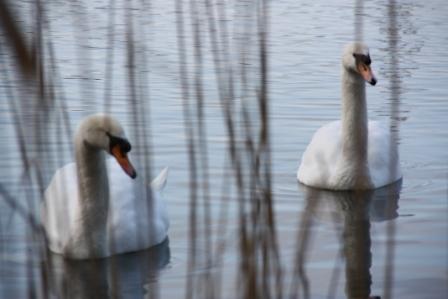
|

|

|

|

|

|

|

|

|

|
Richings Park today ...

Thorney Park Swans
a battle on Thorney Island on the banks of the River Colne in the Anglo Saxon Chronicles of 893. During the reign of Alfred the Great, Britain was continuously attacked by Danes and Vikings and occasionally the incumbent Saxons were able to get the upper hand as at the Battle of Thorney Island. It is thought that In 893, a Viking invading force lead by a Viking named Haesten met the Saxon army lead by Alfred's son Edward at Farnham in Surrey. The Vikings were badly beaten and fled northward, crossing the Thames between Staines and Maidenhead and followed by the Saxons, took refuge on an island in the Colne at Thorney where the river divided. Sadly the Saxon army was only able to besiege them for a short time (several months) until their own food ran out and the army service time of the individual soldiers ran out. King Alfred was making his way towards them when he discovered that his army had virtually disappeared. The Vikings stayed on the island as Haesten had been badly wounded and they could not move him. No mention
is made of their leaving the island but they seemed to have left a lot of their possessions buried there, possibly hoping to recover them later. Archaeological evidence discovered at Larbourne Farm (now demolished) during excavations by the gravel extraction company in the early 1950s and 60s suggested that that was the site of a battle or at least a siege. The most important find was an intact Egyptian Ushbati or Servant of the Dead, a small statue which was placed in tombs to represent the deceased's servant in the afterlife. The fact that there was never any recorded later inhabitation of the site which was extensively farmed down the years and the Viking habit of plundering, it can only be assumed that such artifacts were buried during the siege in the hope of being able to recover them later. The discovery of a Viking sword and a Saxon dagger together in a Mansion Lane gravel pit in 1928 may also be the relics of this and other raids.
Other items recovered in the Larbourne digs included Romano-British and medieval pottery. Some of these were put together to form a narrow necked jar or wine bottle from the 1st or 2nd century; there were also two pieces of a coloured bowl from the 3rd or 4th century and a piece of red Samian ware with the letters MAN stamped on it from between 90 and 120 AD. Animal bones were also found including two antler picks and a large Ox head at least 20,000 years old from a Bos primigenius, the extinct Giant Auroch which reputedly stood some six feet tall. Sadly the subsequent gravel extractions destroyed the site so badly that it will be impossible to find further material and evidence of past activities.
A large wood, Thorney Wood, had covered the area since at least the 1300s and it was an important resource and landmark; in 1546 it was recorded as covering some sixty acres or so. Part of modern day Richings

